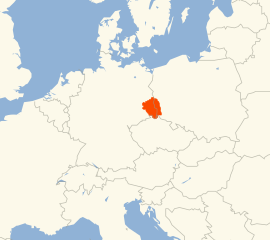
Back Lausitz Afrikaans لوساتيا Arabic Лужыца Byelorussian Лужыца BE-X-OLD Лужица Bulgarian Lužica BS Lusàcia Catalan Lužice Czech Лоужица CU Lausitz Danish
Lusatia
| |
|---|---|
 | |
| Coordinates: 51°32′42.2351″N 14°43′34.1040″E / 51.545065306°N 14.726140000°E | |
| Countries | |
| Largest towns | Cottbus-Chóśebuz Görlitz Bautzen-Budyšin Żary |
| Time zone | UTC+1 (CET) |
| • Summer (DST) | UTC+2 (CEST) |
| Highways | |

Lusatia (German: Lausitz [ˈlaʊ̯zɪt͡s] , Polish: , Upper Sorbian: Łužica [ˈwuʒitsa], Lower Sorbian: Łužyca [ˈwuʒɨtsa], Czech: Lužice) is a historical region in Central Europe, territorially split between Germany and modern-day Poland. Lusatia stretches from the Bóbr and Kwisa rivers in the east to the Pulsnitz and Black Elster rivers in the west, and is located within the German states of Saxony and Brandenburg as well as in the Polish voivodeships of Lower Silesia and Lubusz. Major rivers of Lusatia are the Spree and the Lusatian Neisse, which defines the border between Germany and Poland. The Lusatian Mountains of the Western Sudetes separate Lusatia from Bohemia (Czech Republic) in the south. Lusatia is traditionally divided into Upper Lusatia, the hilly southern part, and Lower Lusatia, the flat northern part.
The areas east and west along the Spree in the German part of Lusatia are home to the Slavic Sorbs, one of Germany’s four officially recognized indigenous ethnic minorities. The Upper Sorbs inhabit Saxon Upper Lusatia, and the Lower Sorbs Brandenburgian Lower Lusatia. Upper and Lower Sorbian are spoken in the German parts of Upper and Lower Lusatia respectively, and the signage there is mostly bilingual. Throughout history, the region has been ruled variously by Poland, Bohemia, Germany and Hungary.
The Lusatian Lake District is Europe's largest artificial lake district. The village of Herrnhut (Ochranow) is the seat of the Moravian Church. Muskau Park in Bad Muskau (Mužakow) and Łęknica is a UNESCO World Heritage Site. The Tropical Islands Resort, a large water park housed in a former airship hangar that is the biggest free-standing hall in the world, is located in the north of Lusatia. The closest international airport to Lusatia is Dresden Airport in Klotzsche (Kłóčow).
The largest Lusatian city is Cottbus (Chóśebuz), with nearly 100,000 inhabitants. Other notable towns are the former members of the Lusatian League: the German/Polish twin towns of Görlitz (Zhorjelc) and Zgorzelec, Bautzen (Budyšin), Zittau (Žitawa), Lubań, Kamenz (Kamjenc), and Löbau (Lubij)), as well as Żary, the German/Polish twin towns of Guben (Gubin) and Gubin, Hoyerswerda (Wojerecy), Senftenberg (Zły Komorow), Eisenhüttenstadt (Pśibrjog), and Spremberg (Grodk).